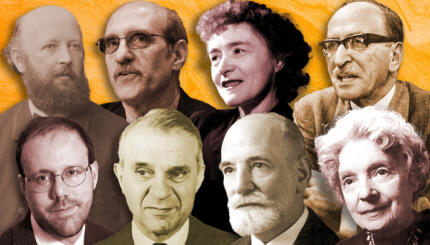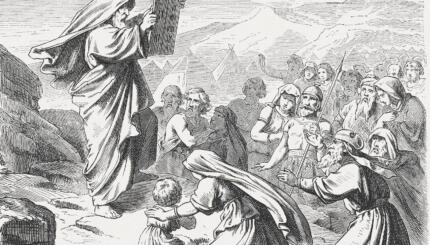By the end of the 20th century, the vast majority of American Jews were fully integrated into American life and increasingly distant from their parents and grandparents’ experiences. During this time, American Jewry witnessed a significant degree of internal diversification. Blending the richness of their own tradition with the American virtues of freedom and pluralism, the community broadened the boundaries of Jewish observance, patterns of worship, and education.
By 1980, discrimination against American Jews in the professions was largely a thing of the past. Virtually no field was (or is) “closed” to Jews, officially or unofficially, including politics. There were more Jews in the House of Representatives and the Senate than ever before, in numbers far exceeding their proportion of the U.S. population. In the 2000 presidential election, Senator Joseph Lieberman, an Orthodox Jew, was the Democratic candidate for vice president.
 American Jews’ social integration was no less remarkable. This achievement, however, was far more complicated. With assimilation into American society came higher rates of intermarriage. Recognizing the changing makeup of the American Jewish population, the Reform movement followed the lead of the Reconstructionist movement and passed its “Resolution on Patrilineal Descent” in 1983. (The Reconstructionist Rabbinical Association was founded in 1974, and formally approved patrilineal descent in 1975.) The resolution ruled that the child of a Jewish father and a non-Jewish mother is considered Jewish, as long as the child is being raised in the Jewish tradition. This ruling reversed a long-held tenet of Jewish law that relied upon matrilineal descent to determine a child’s Jewish status.
American Jews’ social integration was no less remarkable. This achievement, however, was far more complicated. With assimilation into American society came higher rates of intermarriage. Recognizing the changing makeup of the American Jewish population, the Reform movement followed the lead of the Reconstructionist movement and passed its “Resolution on Patrilineal Descent” in 1983. (The Reconstructionist Rabbinical Association was founded in 1974, and formally approved patrilineal descent in 1975.) The resolution ruled that the child of a Jewish father and a non-Jewish mother is considered Jewish, as long as the child is being raised in the Jewish tradition. This ruling reversed a long-held tenet of Jewish law that relied upon matrilineal descent to determine a child’s Jewish status.
The controversy surrounding this decision became more intense with the release of the 1990 National Jewish Population Survey. The NJPS found that roughly half of the Jews married between 1985 and 1990 chose non-Jewish spouses. Jewish communal leaders had to confront the implications of this statistic: How were they to determine, or redetermine, the boundaries of the Jewish community? Were intermarried couples and their children welcome to join synagogues?
The community began to review its priorities. Should Jewish institutions focus on “outreach” and try to engage all Jewish families, even if some of their members did not consider themselves Jews? Those who argued this position, including the Jewish Outreach Institute (founded in 1988) and the Union for Reform Judaism, figured they were simply accepting, and adapting to, the reality of Jewish life in the late-20th century.
Others disagreed, preferring a policy of “in-reach.” They contended it was best to keep the definition of “Jew” more narrow and rigid. Anything else would erase the boundary between Jew and non-Jew, and the distinctiveness of the Jewish community would be lost.
Religious and Educational Innovation
The American Jewish community also celebrated a period of religious and educational creativity during this period. American Jews seeking religious, ethnic, or cultural involvement in the late 20th century had a plethora of choices available to them. Synagogues–both within and outside of the movements–put renewed emphasis on the individual’s worship experience.
Composer and performer Shlomo Carlebach, whose Hasidic-style music was infused with warmth and spirituality, enjoyed popularity across denominations. Carlebach and Rabbi Zalman Schachter-Shalomi contributed to the growth of Jewish Renewal, a non-denominational movement with roots in Hasidism, which emphasized the experience of the worshipper above all else.
Orthodoxy continued to thrive and diversify, particularly Chabad. Under the dynamic leadership of Rabbi Menachem Mendel Schneerson (the Rebbe), the Chabad-Lubavitch movement grew both in the United States and worldwide. Many unaffiliated American Jews who visited Chabad houses experienced Chabad’s enthusiasm for Jewish learning and life. When Schneerson died in 1994 no one succeeded him as Rebbe. The movement still flourished, despite the fact that years after his death, many Lubavitch Jews still consider Schneerson the Messiah.
Also in this period, greater numbers of American Jews participated in programs of Jewish learning. The day school movement expanded rapidly, encompassing both movement-sponsored and pluralistic institutions. Innovative adult learning programs such as Me’ah, the Florence Melton Adult Mini-School, and Wexner Heritage flourished. Informal Jewish learning programs–such as Jewish camps, Israel trips, and youth groups–were key transmitters of Jewish heritage to teens and young adults. Beginning in 2000, the Taglit-Birthright Israel program founded by philanthropists Charles Bronfman and Michael Steinhardt offered free trips to Israel for Jews ages 18 to 26.
A New Feminism
The feminist movement also had an enormous influence on Jewish religious expression and the expanding definition of the Jewish family. Slowly but steadily, women became equal participants in the synagogue service and in its leadership circles. The Conservative movement ordained its first woman rabbi in 1985 (13 years after the Reform movement graduated Sally Priesand). Many adult Jewish women read Torah for the first time as adult b’not mitzvah in the 1980s, having been denied the opportunity years earlier by non-egalitarian practices.
Orthodox Jewish women created their own definitions of feminism. In 1997, Blu Greenberg founded the Jewish Orthodox Feminist Alliance (JOFA), the mission of which is to “expand the spiritual, ritual, intellectual and political opportunities for women within the framework of halakha.”
Gender-neutral language accounted for the thorough revision of many siddurim. For instance, in 1996, the Reform movement revised Gates of Prayer to include gender-sensitive language. The name of God was no longer translated as “He,” but simply as “God.”
Other marginalized groups also asserted their rights to equality in Jewish life. The World Congress of Gay, Lesbian, Bisexual and Transgender Jews was officially founded in 1980 under the name Keshet Ga’avah (Rainbow of Pride) to represent the interests of LGBT Jews and supports their organizations. Today, some 50 organizations are part of the World Congress, among them LGBT synagogues across the United States.
A Changing Community
The American Jewish community underwent significant change in structure during this period, opting in 1999 to combine the United Jewish Appeal, the Council of Jewish Federations, and the United Israel Appeal under one roof. The result of the merger of these three organizations, United Jewish Communities, is the umbrella body that represents more than 150 Jewish federations and 400 independent Jewish communities across North America.
The world of American Jewish politics also grew more diverse between 1980 and 2000, becoming inextricably tied to developments in Israel. Jews and Arabs continued to struggle to work out a lasting peace in the Middle East, but there were repeated terrorist attacks against Israelis. Accompanying security measures taken by the Israeli government were both defended and criticized by Americans. Meanwhile, the Oslo Peace Accords of 1993 offered great hope for finally establishing peace in the Middle East.
American Jews also evinced greater consciousness of the past. The Holocaust rose to the surface of American Jewish memory and culture. In the 1980s and 1990s, virtually every American city built a Holocaust memorial; the opening of the U.S. Holocaust Memorial Museum in 1993 was a widely touted event. As Holocaust survivors diminished in number, Jewish communities perceived an urgent need to preserve the memories of those who perished. Anti-Semitism in contemporary American life was not forgotten on account of a few, but major incidents–in particular the Crown Heights riots of 1991.
A handful of events and political battles no doubt darkened this period, and anticipated challenges to be faced in the coming decades. On balance, however, American Jewry fared remarkably well on the eve of the 350th anniversary of their arrival in this country.
Chabad-Lubavitch
Pronounced: khuh-BAHD loo-BUV-itch (oo as in boot), Hasidic sect known for its outreach to the larger Jewish community.
Torah
Pronunced: TORE-uh, Origin: Hebrew, the Five Books of Moses.


